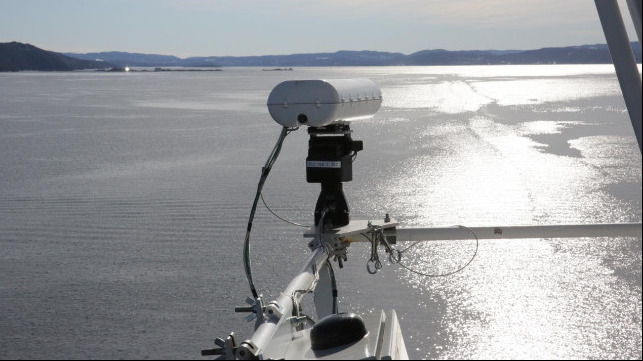Seeing Below The Surface: Ladar Trials Promise Enhanced Vessel Safety

Knowing what lies ahead is essential to safe navigation. Now innovative Ladar technology is being tested onboard operating vessels to help captains to see not only objects on the surface of the water, but underneath.
Ladar is a light-based laser technology anti-collision system that identifies floating objects on or under the surface of the water, including drifting fishing nets, logs, containers and ice, but also plastic and other flotsam.
“We can detect items that lie well ahead, as the ship is sailing,” says Sverre Dokken, founder of Offshore Monitoring, developers of Ladar.
The system was recently put to the test on a Color Line ferry in the seas around Scandinavia, then on a test vessel in the Mediterranean. "Since the beginning of the Ladar system development, we have placed great emphasis on testing the system's performance in every way possible, not only in controlled environments in the laboratory, but also in real-life settings,” Dokken says.
“We recently had the opportunity to set up the system on board Color Magic and execute a series of tests and benchmarks along the Oslo-Kiel route," he relates. The team first detected objects on the route sailing from Oslo to Kiel, then ran the same tests on the return leg to verify the identity of objects detected on the first pass. “The test was a success. First we identified a series of objects, and then we were able to verify the findings,” Dokken reports.
Color Line was particularly interested in learning more about the moving sandbanks in Kattegat, the stretch of water between Denmark and Sweden.
“We want to exploit wind and current conditions in order to reduce resistance and lower fuel consumption, and this sometimes involves varying from the pre-determined course,” says Jan-Helge Pile, Technical Manager in Color Line.
By informing the bridge of the real-time status of moving sand banks, Ladar allows Color Line’s officers to perform safe deviation from the set course, maximizing fuel efficiency without increased risk of grounding.
“The Ladar tests on Color Magic are part of Color Line’s ongoing efforts to promote safer, more efficient shipping,” Pile confirms.
Testing steepens learning curve
“We have a theoretical model, but we need to know more about how Ladar can perform,” says Dokken. “These tests gave us an idea of what it could actually do, and how close we could get to the design optimum.”
While many theories were confirmed during the tests, there were some surprizes as well, Dokken reports: “The system we tested was better at detecting smaller items than we had anticipated, but not as good on metal objects in still water.”
The reason for this: waves caused by wind increase disturbance in the water around an object, making it easier to detect. “This includes up to storm level winds,” Dokken confirms. “The more activity in the water, the better.”
Even when Ladar identified submerged objects, the crew could not always determine exactly what had been detected. “To address this issue, we re-constructed the test under controlled circumstances on our test vessel in the Mediterranean. We deployed plastic and metal objects for the system to identify. Then we stopped when unknown objects were detected, in order to verify their status and log characteristics to include in the next round of testing.”
While a single Ladar unit was deployed on Color Magic, two were used in the Mediterranean. “With two units operating, we could check results against each other. This added an extra dimension, and we improved results on both metal and plastic objects.” In all, seven days of continuous testing were logged.
The development team is currently using test results to create mockups and further test variables. “We are building a new version of Ladar based on these results,” Dokken confirms. The new version is a multi-spectral unit employing 16 transmitters on 16 wavelengths. The prototype is currently under construction, with a target date end of 2020.
Seeking suitable partners
“Now we are looking for more test partners,” Dokken says. “In particular we would like to enlist the fishing fleet, because we know they need to be able to differentiate between fish and flotsam.”
Also high-speed vessels such as ferries are on Dokken’s wish list. “They tend to pick up more debris due to shallow running depths. The hulls skim the surface and draw debris into cooling systems. This causes delays and equipment damage. High speed vessels also run the risk of hitting objects at speed, causing severe structural damage, so they should be prime candidates to benefit from Ladar technology.”
Ladar has a range of up to one nautical mile and is speed independent. “A longer-range setting gives shallower depth penetration, while shorter range penetrates deeper into the water,” Dokken tells.
According to Dokken, Ladar can also benefit many stakeholders with specific needs relating to understanding the nature of the world under the water’s surface. “For example, environmental organizations need to know where garbage is located in the water, beyond the huge garbage patches.” Garbage is a bigger problem when it washes up on shore, he points out. “Once located, debris is simply easier to collect at sea.”
Dokken extends an open invitation to potential test partners and clients to see Ladar in action for themselves. “We have a dedicated test vessel available in the Mediterranean where we can provide first-hand verification of the capabilities of the system. We are exited to have partners to come aboard and experiment with Ladar, to see how it could work for them.”
The products and services herein described in this press release are not endorsed by The Maritime Executive.
